November 2025
The global polyethylene market volume is calculated at 113.2 million tons in 2024, grew to 117 million tons in 2025, and is projected to reach around 158.1 million tons by 2034.The market is expanding at a CAGR of 3.40% between 2025 and 2034.The heavy expansion of the packaging and green initiatives is driving the potential. The heavy expansion of the packaging and green initiatives is driving the potential.
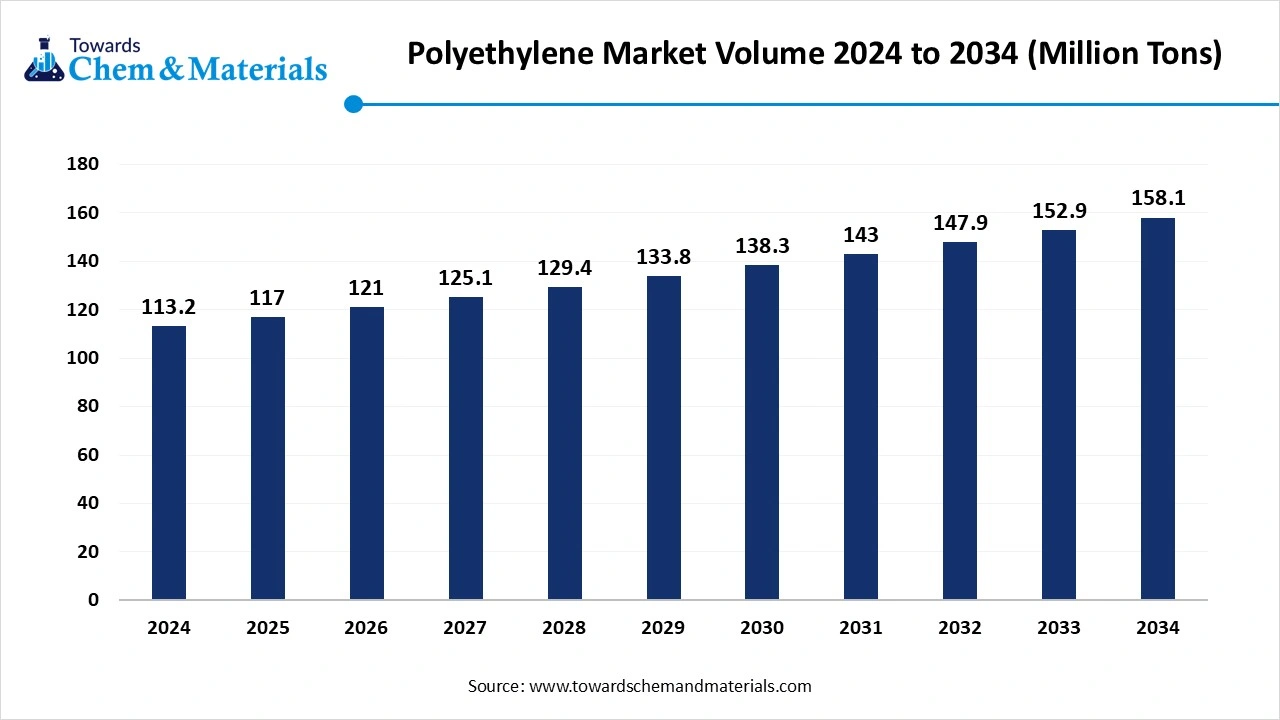
The polyethylene market is witnessing a fast-paced growth, akin to being driven by its versatile applications across industries such as packaging, automotive, construction, and agriculture. The material’s lightweight nature, chemical resistance, and cost-effectiveness continue to make it an ideal choice for manufacturers as it delivers durable and high-performance solutions.
As heavy sectors demand more flexible and efficient materials, polyethylene's adaptability is contributing to the market enhancement in the current period. The sudden rise in demand for eco-friendly and recyclable polyethylene variants has gained major market share recently. This is associated with growing environmental awareness and regulatory pressures, pushing manufacturers to innovate around sustainability
The ongoing enhancement of the flexible packaging sector is spearheading the industry's growth in recent years. As consumer preferences shift toward convenience and product longevity, manufacturers are increasingly adopting polyethylene due to its lightweight, durable, and cost-effective nature. This material’s adaptability in producing films, bags, and wraps for food, pharmaceuticals, and personal care items significantly contributes to the market momentum.
Furthermore, its strong barrier properties and ease of processing make it a preferred choice for innovative packaging formats. As e-commerce continues to grow, the need for secure and efficient packaging further accelerates the demand. Also, the integration of advanced technologies enables high-quality output and better design flexibility, while evolving customer expectations. This growing dependency on polyethylene for packaging applications not only boosts production volumes but also encourages continuous material innovation in the future, as per observation
| Report Attributes | Details |
| Market Volume in 2025 | 117 Million Tons |
| Expected Volume in 2034 | 158.1 Million Tons |
| Growth Rate | CAGR of 3.40% from 2025 to 2034 |
| Base Year of Estimation | 2024 |
| Forecast Period | 2025-2034 |
| High Impact Region | Asia Pacific |
| Segment Covered | By Product Type, By End Use, By Application, By region |
| Key Companies Profiled | BASF SE,Borealis AG, Braskem, Dow, Exxon Mobil Corporation,Formosa Plastics,INEOS Group,LG Chem LyondellBasell Industries Holdings B.V., Mitsubishi Chemical Corporation, MOL Group,SABIC,China Petrochemical Corporation, (Sinopec) |
Original automotive equipment manufacturers (OEMs) are seen under pressure to reduce vehicle weight for better fuel efficiency and lower emissions. Polyethylene components provide a cost-effective, lightweight alternative to metals and other plastics, which is expected to create significant opportunities for the polyethylene market during the forecast period. This shift supports manufacturers investing in high-performance, moldable grades of polyethylene. Also, the increasing adoption of electric vehicles will further contribute to the industry's growth potential.
The polyethylene market is experiencing growing competition from bio-based and biodegradable alternatives. These eco-friendly materials are anticipated to hamper market growth in the coming years, as many industries are now adopting greener substitute solutions to meet corporate social responsibility goals and regulatory regulations. This shift can create significant challenges for manufacturers to reevaluate their product lines and invest in R&D for recyclable polyethylene variants.
Asia Pacific dominated the polyethylene market in 2024. Asia Pacific leads the market due to its massive manufacturing base and rapid industrialization. Also, high demand from the packaging, construction, and automotive sectors fuels consistent consumption.
Moreover, the rising urbanization and infrastructure development across emerging economies like India, China, and Japan are expected to support the market growth in the coming years. Furthermore, strong investments in petrochemical infrastructure enhance regional production capabilities. Also, the favorable government policies and trade dynamics make Asia Pacific a global
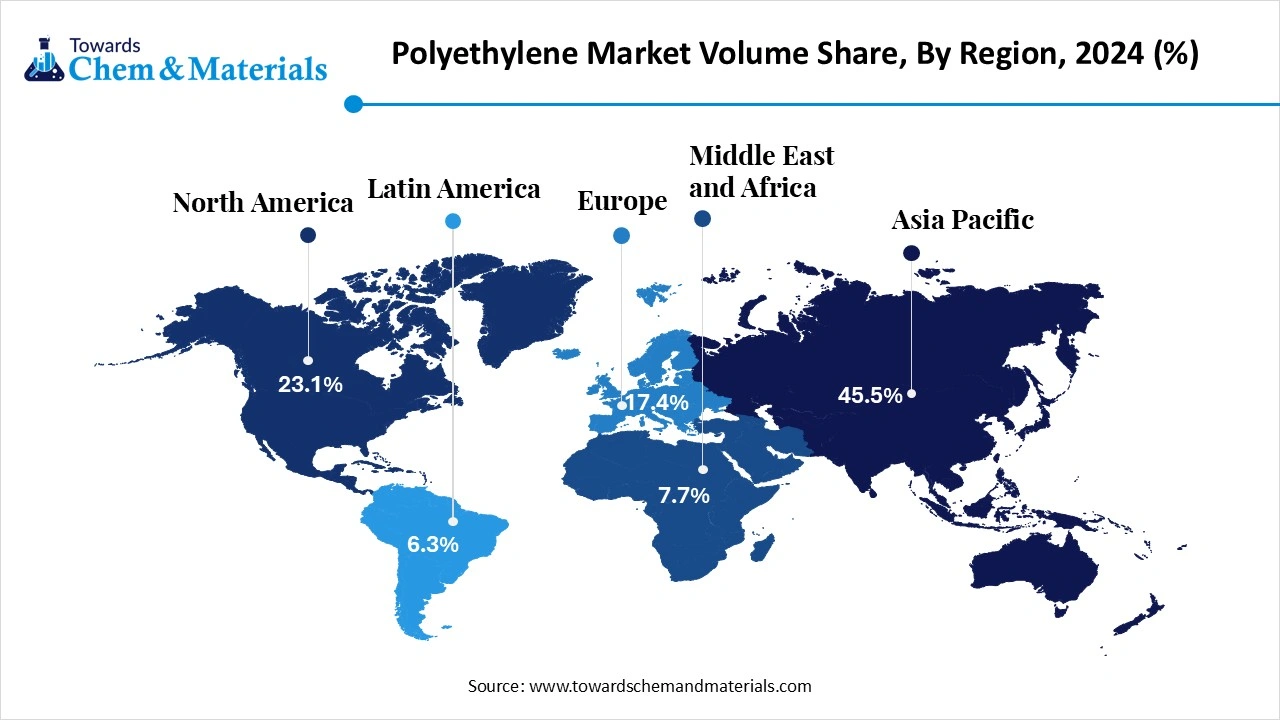
China has maintained its dominance in the Asia Pacific region for the past period. China’s polyethylene demand is mainly driven by its expansive packaging and consumer goods industries in recent times. Unlike the larger region, China focuses heavily on technological upgrades and domestic capacity building in the current industry environment. It continues to import high-grade polyethylene, despite local production expansion efforts. Strategic partnerships and international investments are majorly contributing to the market growth in China nowadays. Sustainability initiatives and circular economy goals are influencing material choices more
North America is expected to grow at the fastest pace in the coming period. North America leads the polyethylene market with its advanced manufacturing ecosystem and technological advancements. The region has an abundant raw material supply, especially shale gas, which gives benefits like steady and cost-effective production.
Strong infrastructure and logistics support smooth distribution across diverse end-user industries. Moreover, growth in the automotive, packaging, and construction sectors drives consistent demand for polyethylene materials. Regulatory initiatives and investment in sustainable plastic production further support regional dominance. Adoption of smart manufacturing practices helps the
Polyethylene Market Volume Share, By Region, 2024 (%)
| By Region | Market Shares (%)2024 | Volume (Million Tons)(2024) | CAGR (2025-2034) |
| North America | 23.1% | 26.1 | 3.84% |
| Europe | 17.4% | 19.7 | 2.60% |
| Asia Pacific | 45.5% | 51.5 | 3.71% |
| Latin America | 6.3% | 7.2 | 1.23% |
| Middle East & Africa | 7.7% | 8.7 | 3.53% |
The United States is expected to play a crucial role in the development of the polyethylene market during the forecast period. The United States contributes a significant share due to its large-scale petrochemical base and export capacity. Major polyethylene producers, including multinational giants, are headquartered and operate heavily within the United States' advanced manufacturing environment.
Also, the United States is seen as pushing innovations in recyclable and performance-based polyethylene types. The domestic market is receiving the benefits from growing e-commerce and flexible packaging needs, increasing polyethylene demand. Aggressive sustainability goals and recycling mandates are
The high-density polyethylene segment held the dominating share of the polyethylene market in 2024. Having a superior strength-to-density ratio, offering robustness across applications, high-density polyethylene has gained popularity in recent years. Also, its adaptability in pipe systems, containers, and heavy-duty packaging makes it an ideal industrial choice.
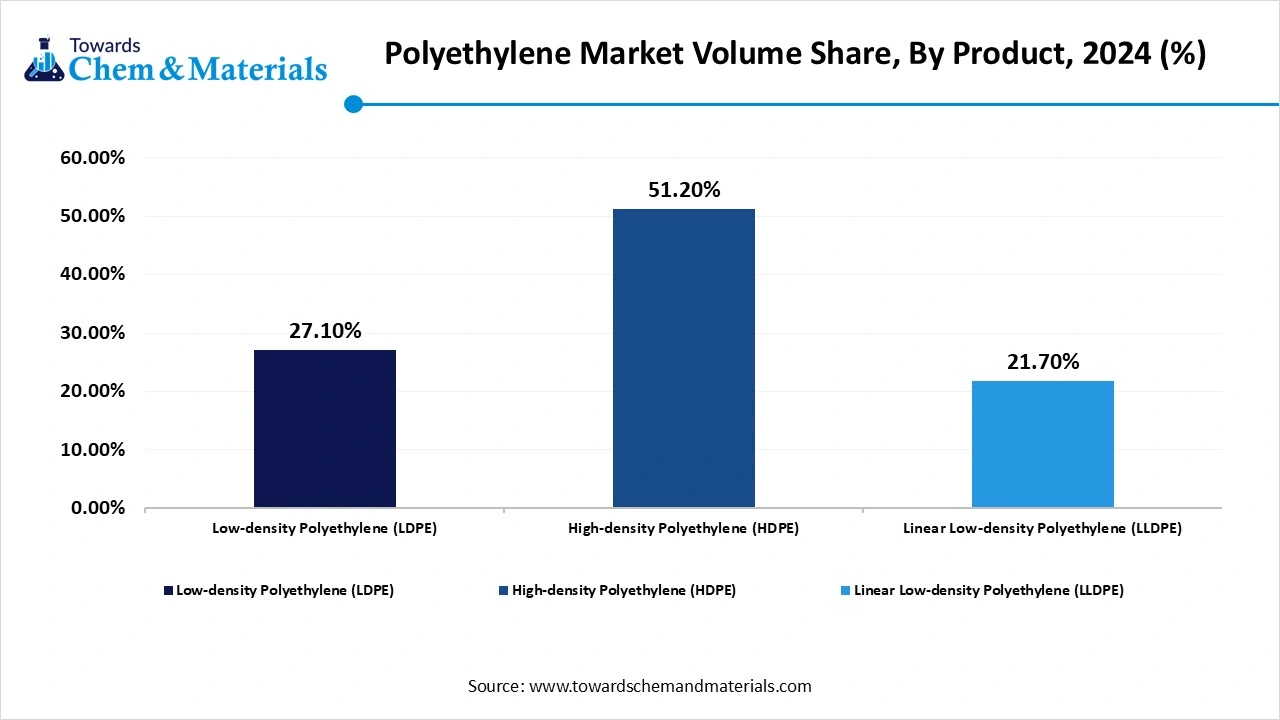
The material's resistance to moisture, impact, and chemicals enhances its performance in various environments. HDPE's compatibility with molding technologies supports efficient, high-volume production. Construction and automotive sectors are majorly contributing to the segment growth in the current industry environment. Cost-efficiency and recyclability further confirm their stronghold in the market space. The low-density polyethylene segment is expected to experience significant polyethylene market growth in the future.
Low-density polyethylene is expected to gain momentum mainly due to its exceptional flexibility and puncture resistance properties. It supports thinner film applications, reducing material use while maintaining durability. It can play a major role in stretch wraps, agricultural films, and flexible packaging, while ensuring evolving industrial needs in the future. Growing demand for lightweight, high-performance materials across sectors
Polyethylene Market Volume Share, By Product, 2024 (%)
| By Product | Market Volume Shares (%) 2024 | Volume (Million Tons)(2024) | CAGR (2025-2034) |
| Low-density Polyethylene (LDPE) | 27.1% | 30.7 | 3.56% |
| High-density Polyethylene (HDPE) | 51.2% | 58.0 | 3.11% |
| Linear Low-density Polyethylene (LLDPE) | 21.7% | 24.5 | 3.86% |
The bottles and containers segment held the dominating share of the polyethylene market in 2024, akin to its high demand in packaging solutions across food, beverages, and personal care products. Moreover, polyethylene’s versatility, cost-effectiveness, and ability to provide barrier properties for product protection contribute to its widespread use and market growth.
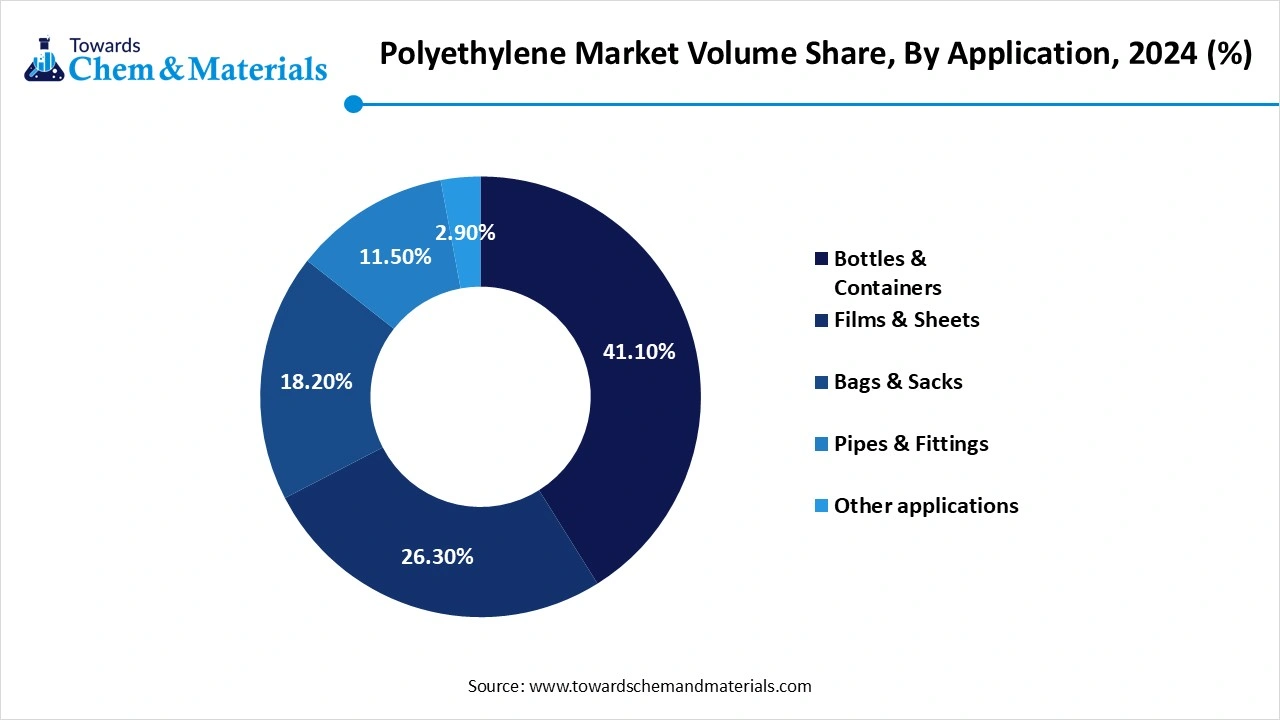
Additionally, the rising preference for lightweight and durable packaging further drives the segment enhancement. Consumer demand for safe, eco-friendly packaging options has also contributed to the growth of the segment in the current period. The recyclability of polyethylene bottles and containers enhances their appeal in sustainability-focused markets. As industries prioritize convenience, this segment continues to lead the polyethylene application market.
The films and sheets segment are expected to experience significant market growth in the future, owing to its extensive use in agricultural, industrial, and retail applications. As the polyethylene films offer high flexibility, moisture resistance, and durability, making them ideal for packaging, greenhouse covers, and construction films, they will gain market momentum during the forecast period.
The growing trend of e-commerce packaging is driving demand for flexible packaging solutions. With the sustainability trend, innovations in biodegradable films are expected to fuel future growth. Increased awareness of the environmental impact of plastic packaging will push the development of eco-friendly polyethylene alternatives in this segment. As consumer preferences shift towards convenience and efficiency, the dominance of films and sheets in the polyethylene market will continue to rise.
Polyethylene Market Volume Share, By Application, 2024 (%)
| By Application | Market Volume Shares (%)2024 | Volume (Million Tons)(2024) | CAGR (2025-2034) |
| Bottles & Containers | 41.1% | 46.5 | 2.96% |
| Films & Sheets | 26.3% | 29.8 | 3.72% |
| Bags & Sacks | 18.2% | 20.6 | 3.93% |
| Pipes & Fittings | 11.5% | 13.0 | 3.67% |
| Other applications | 2.9% | 3.3 | 1.98% |
The packaging segment dominated the market with the largest share in 2024 due to the increasing need for lightweight, flexible, and durable properties. Polyethylene’s ability to provide effective protection, reduce shipping costs, and maintain product integrity has made it a preferred choice in packaging applications. As e-commerce continues to expand, demand for cost-efficient and sustainable packaging solutions grows, further driving polyethylene's use. Additionally, innovations in biodegradable polyethylene are increasing the segment's potential. The sector’s dependence on large volumes of plastic packaging contributes
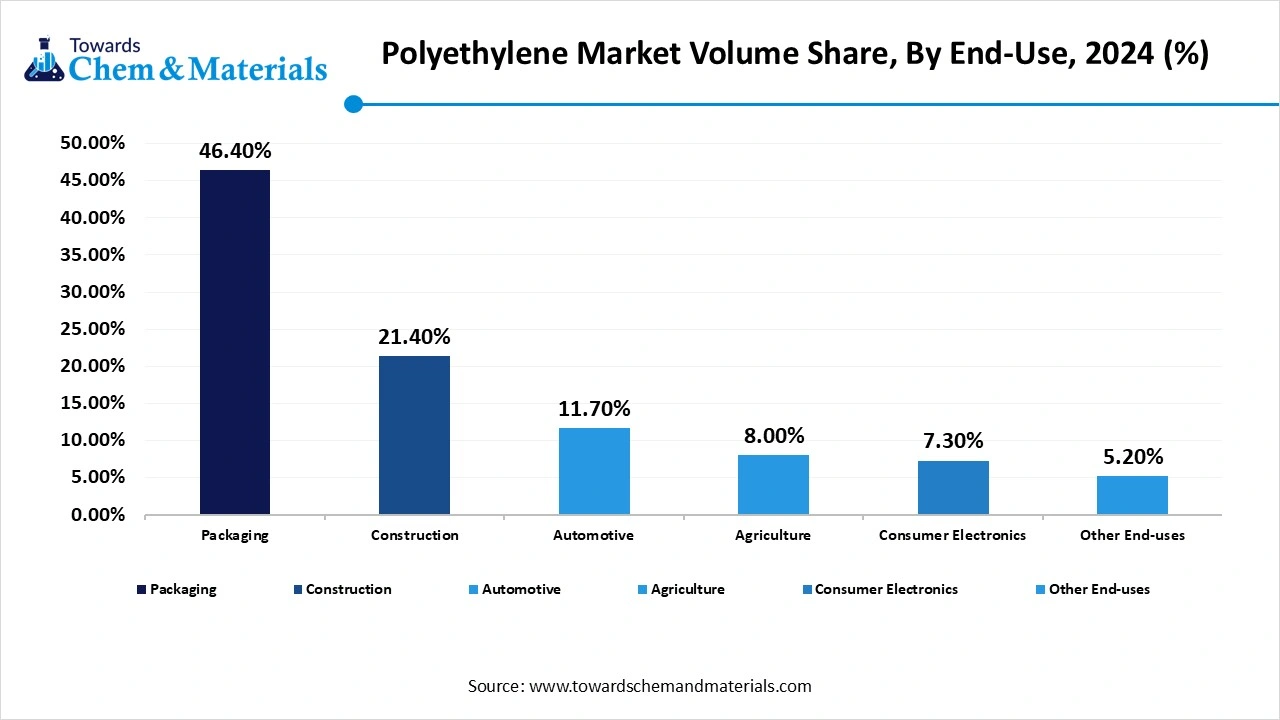
The construction segments are expected to grow at the fastest rate in the market during the forecast period owing to increasing urbanization and infrastructure development during the forecast period. The polyethylene's versatility in applications such as piping, insulation, and vapor barriers makes it indispensable for construction projects in the future, as per market observations. The rising demand for durable, cost-effective, and lightweight materials will continue to push up their growth in this sector. Additionally, polyethylene’s resistance to corrosion and environmental factors positions it as an ideal material for modern construction needs. As the push for more sustainable construction materials intensifies, polyethylene's potential in eco-friendly solutions further boosts its future dominance.
Polyethylene Market Volume Share, By End-Use, 2024 (%)
| By End-Use | Market Volume Shares (%)2024 | Volume (Million Tons)(2024) | CAGR (2025-2034) |
| Packaging | 46.4% | 52.5 | 3.18% |
| Construction | 21.4% | 24.2 | 3.57% |
| Automotive | 11.7% | 13.3 | 4.38% |
| Agriculture | 8.0% | 9.0 | 2.95% |
| Consumer Electronics | 7.3% | 8.3 | 4.39% |
| Other End-uses | 5.2% | 5.9 | 1.33% |
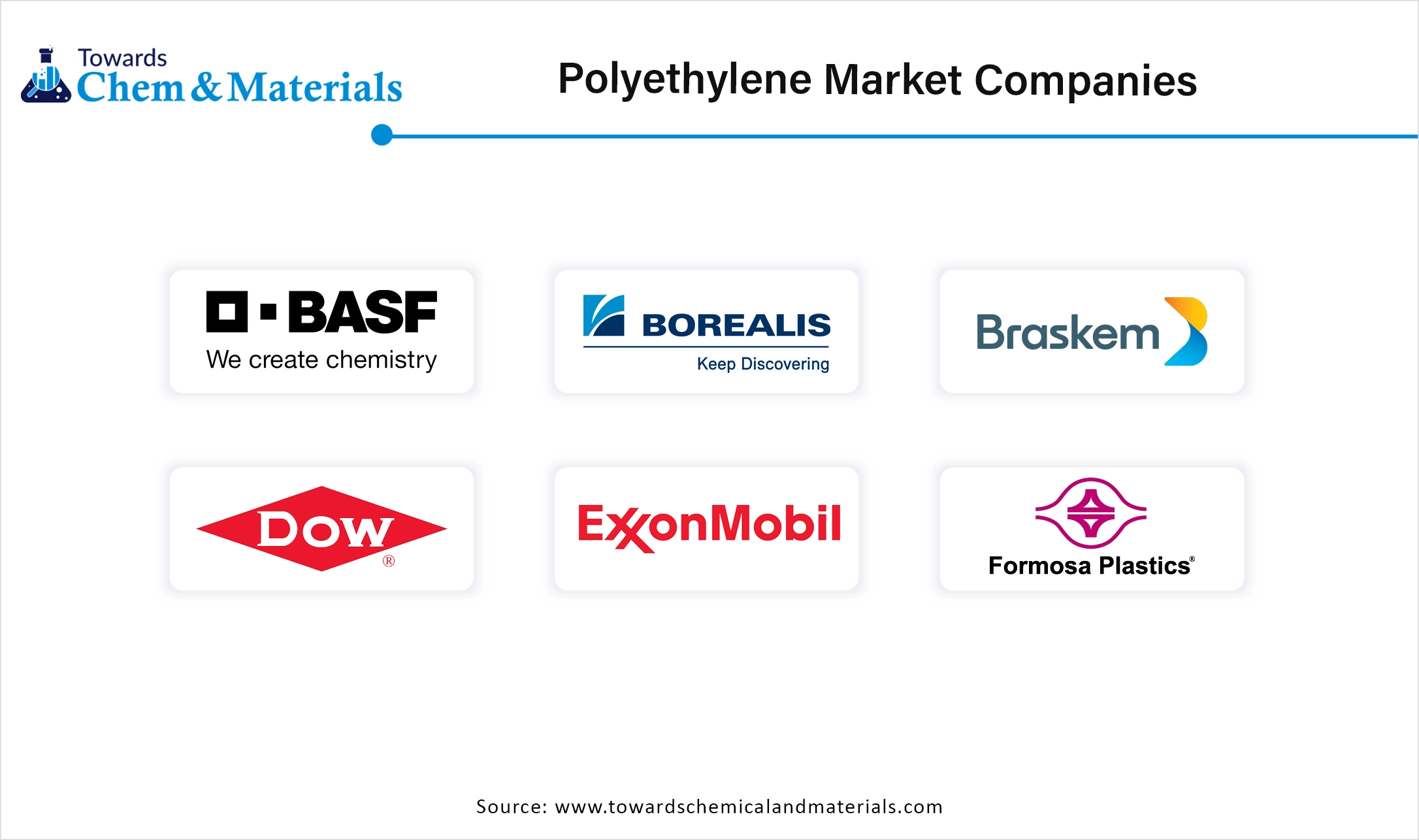
By Product Type
By End Use
By Application
By Region
November 2025
November 2025
November 2025
November 2025